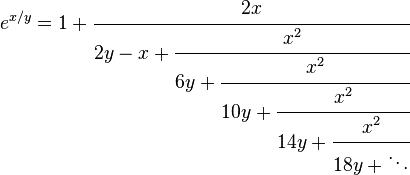List of representations of e
| Part of a series of articles on the |
| mathematical constant e |
|---|
 |
| Properties |
| Applications |
| Defining e |
| People |
| Related topics |
The mathematical constant e can be represented in a variety of ways as a real number. Since e is an irrational number (see proof that e is irrational), it cannot be represented as a fraction, but it can be represented as a continued fraction. Using calculus, e may also be represented as an infinite series, infinite product, or other sort of limit of a sequence.
As a continued fraction
Euler proved that the number e is represented as the infinite simple continued fraction[1] (sequence A003417 in OEIS):
Its convergence can be tripled by allowing just one fractional number:
Here are some infinite generalized continued fraction expansions of e. The second is generated from the first by a simple equivalence transformation.
This last, equivalent to [1; 0.5, 12, 5, 28, 9, ...], is a special case of a general formula for the exponential function:
As an infinite series
The number e can be expressed as the sum of the following infinite series:
 for any real number x.
for any real number x.
In the special case where x = 1, or −1, we have:
 ,[2] and
,[2] and
Other series include the following:
 where
where  is the
is the  Bell number. Some few examples: (for n=1,2,3)
Bell number. Some few examples: (for n=1,2,3)
As an infinite product
The number e is also given by several infinite product forms including Pippenger's product
where the nth factor is the nth root of the product
as well as the infinite product
As the limit of a sequence
The number e is equal to the limit of several infinite sequences:
 and
and
![e=\lim_{n \to \infty} \frac{n}{\sqrt[n]{n!}}](../I/m/1ece0ee65e250a7a3ec0a38140ef258c.png) (both by Stirling's formula).
(both by Stirling's formula).
may be obtained by manipulation of the basic limit definition of e.
The next two definitions are direct corollaries of the prime number theorem[8]
where  is the nth prime and
is the nth prime and  is the primorial of the nth prime.
is the primorial of the nth prime.
where  is the prime counting function.
is the prime counting function.
Also:
In the special case that  , the result is the famous statement:
, the result is the famous statement:
In trigonometry
Trigonometrically, e can be written as the sum of two hyperbolic functions:
Notes
- ↑ Sandifer, Ed (Feb 2006). "How Euler Did It: Who proved e is Irrational?" (PDF). MAA Online. Retrieved 2010-06-18.
- ↑ Brown, Stan (2006-08-27). "It’s the Law Too — the Laws of Logarithms". Oak Road Systems. Retrieved 2008-08-14.
- ↑ Formulas 2–7: H. J. Brothers, Improving the convergence of Newton's series approximation for e, The College Mathematics Journal, Vol. 35, No. 1, (2004), pp. 34–39.
- ↑ J. Sondow, A faster product for pi and a new integral for ln pi/2, Amer. Math. Monthly 112 (2005) 729–734.
- ↑ J. Guillera and J. Sondow, Double integrals and infinite products for some classical constants via analytic continuations of Lerch's transcendent,Ramanujan Journal 16 (2008), 247–270.
- ↑ H. J. Brothers and J. A. Knox, New closed-form approximations to the Logarithmic Constant e, The Mathematical Intelligencer, Vol. 20, No. 4, (1998), pp. 25–29.
- ↑ Khattri, Sanjay. "From Lobatto Quadrature to the Euler constant e" (PDF).
- ↑ S. M. Ruiz 1997
![e = [2; 1, \textbf{2}, 1, 1, \textbf{4}, 1, 1, \textbf{6}, 1, 1, \textbf{8}, 1, 1, \ldots, \textbf{2n}, 1, 1, \ldots]. \,](../I/m/946a5f54da53ea25f2375a178bd5b4b3.png)
![e = [ 1 ; \textbf{0.5} , 12 , 5 , 28 , 9 , 44 , 13 , 60 , 17 , \ldots , \textbf{4(4n-1)} , \textbf{4n+1} , \ldots]. \,](../I/m/f1fefcfeb3ef05a5ced5fd6e35c940e7.png)




![e = \left [ \sum_{k=0}^\infty \frac{1-2k}{(2k)!} \right ]^{-1}](../I/m/347be98b47bdc3e043fe243d36c189c9.png)




![e = \left [ \sum_{k=0}^\infty \frac{4k+3}{2^{2k+1}\,(2k+1)!} \right ]^2](../I/m/6c4187bccdf5b7cea4115c87ffa31868.png)
![e = \left [ -\frac{12}{\pi^2} \sum_{k=1}^\infty \frac{1}{k^2} \ \cos \left ( \frac{9}{k\pi+\sqrt{k^2\pi^2-9}} \right ) \right ]^{-1/3}](../I/m/b3c4e120278f9991c780bea7e7cdc772.png)










![e=\lim_{n \to \infty} \left [ \frac{(n+1)^{n+1}}{n^n}- \frac{n^n}{(n-1)^{n-1}} \right ]](../I/m/a5a7a2f503a54c1cfaf249f1fa146ebc.png)




